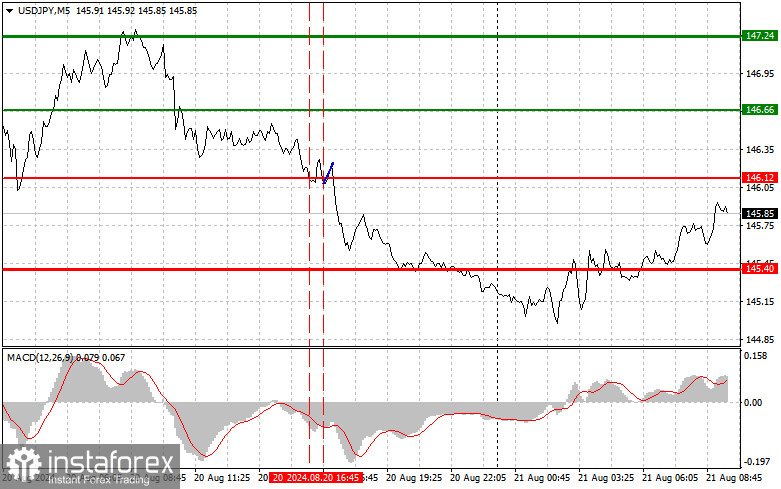Analysis of trades and tips on USD/JPY
The price test of 146.12 occurred when the MACD indicator had moved significantly down from the zero mark, which, in my view, limited the pair's downward potential. For this reason, I did not sell the dollar and decided to wait for the implementation of scenario No. 2 for buying. After a short period, another test at 146.12 during the MACD's recovery from the oversold area seemed to provide a suitable entry point for buying the dollar. However, as you can see on the chart, the pair did not rise, resulting in a loss being realized. Today, weak data on Japan's external trade balance has exerted some pressure on the yen. It is quite challenging to discuss the further direction, as despite the U.S. dollar's weakness against several other risk assets recently, the USD/JPY pair is not showing a clear downward trend. Each decline sees dollar buyers attempting to re-enter the market. As for the intraday strategy, I will rely more on scenarios No. 1 and 2.

Buy signals
Scenario No. 1. Today, I plan to buy USD/JPY when it reaches the entry point around 146.15, plotted by the green line on the chart, with the goal of rising to 146.70, plotted by the thicker green line on the chart. In the area of 147.70, I will exit long positions and open short positions in the opposite direction, expecting a movement of 30-35 pips in the opposite direction from the level. We can count on the pair to rise today as part of the upward correction. Important: Before buying, ensure the MACD indicator is above the zero mark and starting to rise from it.
Scenario No. 2. I also plan to buy USD/JPY today in case of two consecutive tests of 145.57 when the MACD indicator is in the oversold area. This will limit the pair's downward potential and lead to a reverse market upturn. We can expect growth to the opposite levels of 146.15 and 146.70.
Sell signals
Scenario No. 1. I plan to sell USD/JPY today only after testing the level of 145.57 plotted by the red line on the chart, which will lead to a rapid decline in the pair. The key target for sellers will be the level of 145.00, where I will exit short positions and immediately open long positions in the opposite direction, expecting a movement of 20-25 pips in the opposite direction from that level. Pressure on USD/JPY may return at any moment, especially in case of unsuccessful correction in the first half of the day and failure to test the daily high. Important: Before selling, ensure the MACD indicator is below the zero mark and starting to decline.
Scenario No. 2. I also plan to sell USD/JPY today in case of two consecutive tests of 146.15 when the MACD indicator is in the overbought area. This will limit the pair's upward potential and lead to a reverse market downturn. We can expect a decline to the opposite level of 145.57 and 145.00.

What's on the chart:
Thin green line: the entry price at which you can buy the trading instrument.
Thick green line: the estimated price at which you can set Take Profit or manually close positions, as further growth above this level is unlikely.
Thin red line: the entry price at which you can sell the trading instrument.
Thick red line: an estimated price at which you can place Take Profit or manually close positions, as further decline below this level is unlikely.
MACD indicator: when entering the market, it is essential to be guided by overbought and oversold zones.
Important: Novice traders in the forex market must be cautious when deciding to enter the market. It is best to stay out of the market before important fundamental reports are released to avoid getting caught in sharp price fluctuations. If you decide to trade during news releases, always place stop orders to minimize losses. You must set stop orders to avoid losing your entire deposit, especially if you don't use money management and trade in large volumes.
Remember, a clear trading plan, like the one I've outlined, is essential for successful trading. Making impulsive decisions based on the current market situation is a losing strategy for novice intraday traders.
 English
English 
 Русский
Русский Bahasa Indonesia
Bahasa Indonesia Bahasa Malay
Bahasa Malay ไทย
ไทย Español
Español Deutsch
Deutsch Български
Български Français
Français Tiếng Việt
Tiếng Việt 中文
中文 বাংলা
বাংলা हिन्दी
हिन्दी Čeština
Čeština Українська
Українська Română
Română

